In the nonprofit sector, uncertainty is nothing new. But the current funding landscape—with declining federal support and growing pressure on private philanthropy—has pushed many organizations to the edge of their comfort zone.
That’s why Elevate’s second session in our 2025 Conversation Series struck a chord. Titled Doing Less with Less, the virtual event on March 6, 2025 brought together leaders from across the country to face today’s biggest challenges head-on. We were joined by Elevate’s Founder and CEO, Alayna Buckner, as well as the Co-Founder and CEO of 20 Degrees, Sara Gibson. Alayna and Sara provided thoughtful and practical advice for nonprofit leaders at this moment of uncertainty.
Here are the five questions nonprofit professionals are asking most—and the practical steps you can take right now.
1. What should I be doing right now?
Let’s face it: being a nonprofit leader today means holding uncertainty in one hand and responsibility in the other.
Here’s what to focus on:
- Do an exposure assessment: Evaluate your programs and funding sources. Which initiatives or budget line items are most at risk if grants or federal dollars are cut?
- Plan for multiple futures: Think worst-case, best-case, and everything in between. Give each scenario a name (yes, really—it helps make the process easier to manage).
- Strengthen your relationships: Talk to your board, funders, elected officials, and peer orgs. Communicate early, clearly, and often.
These early steps align with the mindset we explored in this previous blog post on adapting to uncertainty, which offers additional ways to stay grounded and proactive before making major decisions.
2. How do I make decisions when the future is uncertain?
No one has a crystal ball. But that doesn’t mean you can’t plan.
Smart moves to make now:
- Clarify your criteria: Get grounded in your mission, values, community needs, and financial picture.
- Differentiate major vs. routine decisions: Don’t freeze. Some choices—like whether to backfill a role—can buy you time while you wait for more clarity on the larger, strategic decisions you’ll need to make.
- Explore your option set: Cutting costs, shifting resources, pausing programs, or pursuing mergers are all on the table.
Bonus tip: Download 20 Degrees’ Resilience Roadmap for a hands-on framework to help guide your planning process.
3. What should I do if there’s just not enough funding?
It’s a hard truth: sometimes the numbers just don’t work.
What to do when you’re facing shortfalls:
- Get clear on your tipping point: Know the exact conditions that would lead you to pause or end a program.
- Create a closure checklist: Have a plan for winding down responsibly, including how you’ll communicate with stakeholders, other organizations where you can refer clients, and the methods in which you’ll document learnings.
- Plan for a comeback: If funding comes back down the line, you’ll want to be ready to relaunch.
 Remember: your mission is bigger than any single program. That mindset shift can make these decisions a little less painful—and a lot more strategic.
Remember: your mission is bigger than any single program. That mindset shift can make these decisions a little less painful—and a lot more strategic.
4. How do I make time for planning when I’m already swamped?
You’re juggling more than ever, and now you’re supposed to plan on top of that?
Try this:
- Honor your energy: Schedule planning time when you’re most focused—even if it’s just 20 minutes a week.
- Share the load: Involve your senior team and your finance folks. This doesn’t have to be a solo project.
- Make a “stop doing” list: What can you pause for the next 4–6 weeks to free up space for the work that matters most?
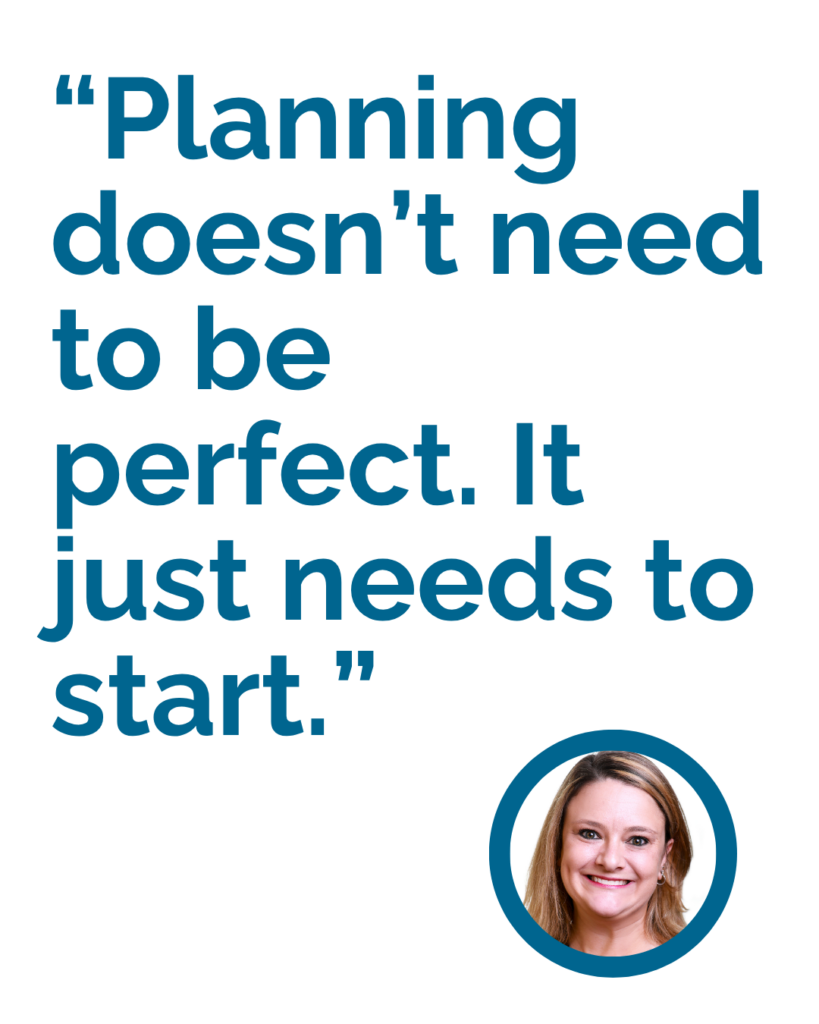 Planning doesn’t need to be perfect. It just needs to start.
Planning doesn’t need to be perfect. It just needs to start.
5. How do I get my Board more engaged right now?
When funding shifts, your board’s role becomes even more critical—but also more complex.
Tips for stronger board engagement:
- Communicate early and clearly: Avoid surprises. Consider holding a special meeting with a single-issue agenda.
- Balance realism with possibility: Share challenges, but also offer a path forward. Help them stay hopeful and informed.
- Clarify expectations: Your board probably won’t fill budget gaps—but they can help advocate, fundraise, and spread the word.
And remember: business-minded board members may need extra guidance to understand the social sector’s priorities and constraints.
Final Thoughts
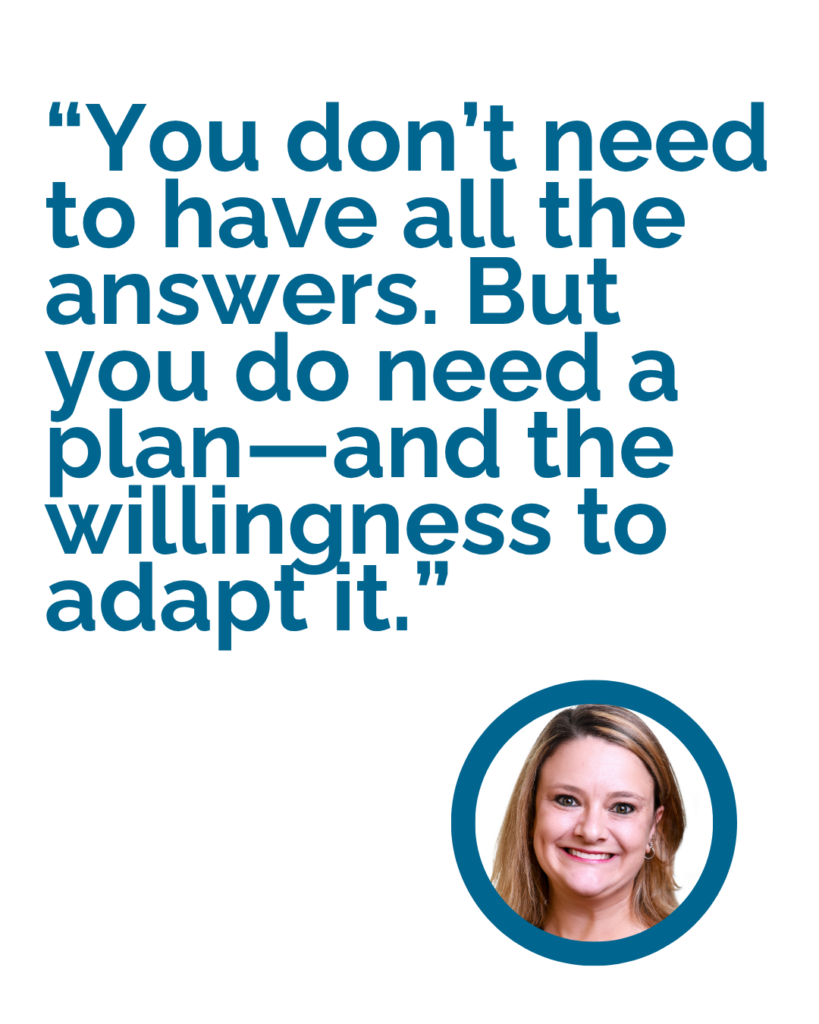 You don’t need to have all the answers. But you do need a plan—and the willingness to adapt it.
You don’t need to have all the answers. But you do need a plan—and the willingness to adapt it.
Whether you’re evaluating programs, weighing funding scenarios, or just trying to protect your team’s energy, one thing is clear: the work you’re doing matters. And you don’t have to do it alone.
Additional Resources
12 Urgent Financial Action Steps – Nonprofit Financial Commons
Strategy Triage Tool – Center for Community Investment
Checklist for Winding Down a Program – Nonprofit Risk Management Center
4 Things Nonprofits Can Do Now, to Better Adapt to Uncertainty – Elevate Blog
Resilience Roadmap – 20 Degrees
If you’re a grant seeker, you’ve likely encountered these scenarios.
Scenario 1: You have an existing, positive relationship with a funder. You’ve submitted a proposal for an expanded or new initiative you thought would interest them, but you received a polite decline.
Scenario 2: You identified a perfect new funding prospect. You submitted an inaugural proposal after receiving the greenlight on an LOI, but ultimately the funder did not make an award.
We’ve all been there.
No one relishes hearing the word NO in response to a funding request. While sources vary, an estimated 80% of grant proposals are declined, so any grantseeker is bound to experience their share of rejections. But when you consider – as in all things in life! – that timing is everything, a “No” doesn’t have to remain a “No” for all time. It might help to think of “No” as “Not right now.”
To that end, the team at Elevate pulled together a few of our tried-and-true tips to help you convert a funder NO into a future YES.
1. Open yourself to feedback.
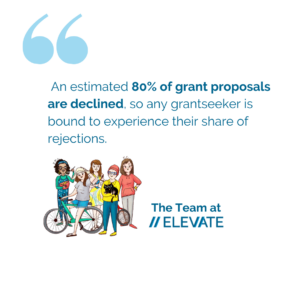 There are many factors that go into funding decisions, both subjective and objective. While you believe in your mission and your organization does excellent work, don’t let that stand in the way of seeing how you can get another bite at the apple. Treat the declination as a valuable learning experience.
There are many factors that go into funding decisions, both subjective and objective. While you believe in your mission and your organization does excellent work, don’t let that stand in the way of seeing how you can get another bite at the apple. Treat the declination as a valuable learning experience.
In addition to graciously thanking the funder for their consideration, invest the time in asking what you could do differently to increase your chances of securing the grant in the next cycle.
If a funder shares any questions or concerns that arose from the proposal, use these inputs to help you shore up those elements for the next grant cycle, make your proposal more compelling, or strengthen an appeal to a different funder who may be interested in your project.
Additionally, in the case of funders that you have not been able to cultivate prior to a request, your first grant proposal might simply be your opportunity to introduce yourself. Consider that even if a proposal was declined, if it opened the door for you to develop a relationship with a new funder, it was by no means a waste of time or effort. Use any communication as an opportunity to reiterate your alignment with the funder’s interests and ask for feedback and an opportunity to apply again in the future.
2. Request a follow-up conversation.
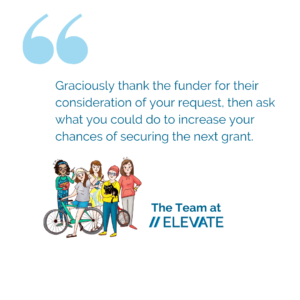 Not all program officers have the time or capacity to hold follow-up conversations about a declined proposal, but many do! Unless they explicitly state otherwise, you should absolutely take the opportunity to request feedback from the funder about your proposal. Request a phone call or meeting, and ask them how you may position yourself to be a more competitive applicant next time around. You can also gauge their interest in other facets of your programming in case something your organization does interests them more than what you originally proposed.
Not all program officers have the time or capacity to hold follow-up conversations about a declined proposal, but many do! Unless they explicitly state otherwise, you should absolutely take the opportunity to request feedback from the funder about your proposal. Request a phone call or meeting, and ask them how you may position yourself to be a more competitive applicant next time around. You can also gauge their interest in other facets of your programming in case something your organization does interests them more than what you originally proposed.
A meeting with a foundation program officer or Board member is a chance to get some behind-the-scenes information. For example, one Elevate team’s client was ostensibly within the funder’s geographic footprint based on eligibility criteria. However, upon speaking to the program officer, our client learned that the foundation had yet to ramp up their giving in the specific neighborhood where the organization is situated, and that they plan to do so the following year. With this encouraging news, the Elevate team planned to submit another request when the foundation was more likely to award a grant to our client.
Alternatively, if it’s challenging to get a meeting on the books, you could ask the funder via phone or email whether they would encourage your organization to reapply during the next grant cycle. Their response may end up yielding some useful insight about your likelihood of securing funding in the future.
3. Seek opportunities to expand your funder network.
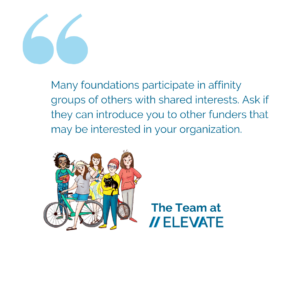 For the most part, foundations operate within a landscape of like-minded organizations, just as nonprofits do. Many funders maintain networks of other philanthropic organizations that share aspects of their giving priorities, and they may even participate in an affinity group of foundations with shared interests. For this reason, after a foundation declines your proposal, it can be valuable to appeal to the funder’s expertise when it comes to other organizations that share their funding priorities. Ask them about other organizations or foundations that they think may be interested in your work, and don’t be afraid to request an introduction to a good point of contact.
For the most part, foundations operate within a landscape of like-minded organizations, just as nonprofits do. Many funders maintain networks of other philanthropic organizations that share aspects of their giving priorities, and they may even participate in an affinity group of foundations with shared interests. For this reason, after a foundation declines your proposal, it can be valuable to appeal to the funder’s expertise when it comes to other organizations that share their funding priorities. Ask them about other organizations or foundations that they think may be interested in your work, and don’t be afraid to request an introduction to a good point of contact.
4. Offer to keep the funder in the loop about your organization.
Fundraising is a long game, so it’s important to be persistent when building a relationship with a grantmaker. As part of your stewardship efforts, you might offer to send periodic updates about your organization’s work or seek to connect with a potential funder through a site visit or a networking event. As a result, they may better understand your work – and your alignment with their interests – the next time you request funding.
5. Refine your prospecting strategy.
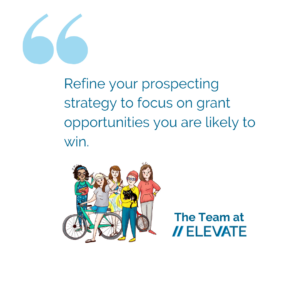 Sometimes, a “No” truly is a “No.” If a program officer makes this explicit, it is not going to do you any good to persist—and may harm your organization’s reputation if you do!
Sometimes, a “No” truly is a “No.” If a program officer makes this explicit, it is not going to do you any good to persist—and may harm your organization’s reputation if you do!
However, this does not mean there isn’t something to learn from the scenario. Reflect on where you misunderstood your organization’s alignment with the funder’s interest, and use this to refine your prospecting strategy so that you can focus on grant opportunities that you are more likely to win.
Consider this example: A nonprofit organization focused on providing services to people who are unhoused submits a grant request to a funder with a broad priority of “housing security”. The request is declined, and after following up to ask for feedback from the program officer, the organization learns that this grantmaker invests in advocacy and systems change organizations rather than those providing direct services. With this information, the nonprofit refines its prospecting strategy to ensure that in the future it pursues grant opportunities with a clear interest in funding direct services.
The bottom line: In order to build a grant program, you are going to hear “No.” But do not despair! Your next steps will make all the difference when it comes to building relationships and refining your grantseeking strategy. And, sometimes you can make bad news work for you!
For more on how to make the most out of a declination, check out this article on Candid. Relatedly, see our blogs on “5 Reasons to Cultivate Relationships with Funders” and “5 Ways to be Pleasantly Persistent with Funder Cultivation.”







 Planning doesn’t need to be perfect. It just needs to start.
Planning doesn’t need to be perfect. It just needs to start. You don’t need to have all the answers. But you
You don’t need to have all the answers. But you  There are many factors that go into funding decisions, both subjective and objective. While you believe in your mission and your organization does excellent work, don’t let that stand in the way of seeing how you can get another bite at the apple. Treat the declination as a valuable learning experience.
There are many factors that go into funding decisions, both subjective and objective. While you believe in your mission and your organization does excellent work, don’t let that stand in the way of seeing how you can get another bite at the apple. Treat the declination as a valuable learning experience.  Not all program officers have the time or capacity to hold follow-up conversations about a declined proposal, but many do! Unless they explicitly state otherwise, you should absolutely take the opportunity to request feedback from the funder about your proposal. Request a phone call or meeting, and ask them how you may position yourself to be a more competitive applicant next time around. You can also gauge their interest in other facets of your programming in case something your organization does interests them more than what you originally proposed.
Not all program officers have the time or capacity to hold follow-up conversations about a declined proposal, but many do! Unless they explicitly state otherwise, you should absolutely take the opportunity to request feedback from the funder about your proposal. Request a phone call or meeting, and ask them how you may position yourself to be a more competitive applicant next time around. You can also gauge their interest in other facets of your programming in case something your organization does interests them more than what you originally proposed.  For the most part, foundations operate within a landscape of like-minded organizations, just as nonprofits do. Many funders maintain networks of other philanthropic organizations that share aspects of their giving priorities, and they may even participate in an
For the most part, foundations operate within a landscape of like-minded organizations, just as nonprofits do. Many funders maintain networks of other philanthropic organizations that share aspects of their giving priorities, and they may even participate in an  Sometimes, a “No” truly is a “No.” If a program officer makes this explicit, it is not going to do you any good to persist—and may harm your organization’s reputation if you do!
Sometimes, a “No” truly is a “No.” If a program officer makes this explicit, it is not going to do you any good to persist—and may harm your organization’s reputation if you do!